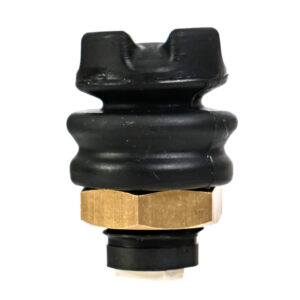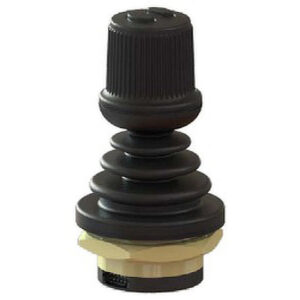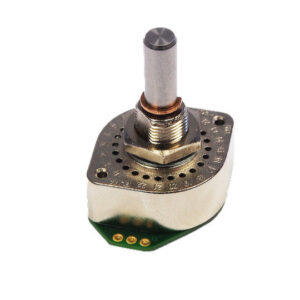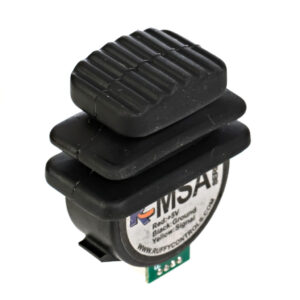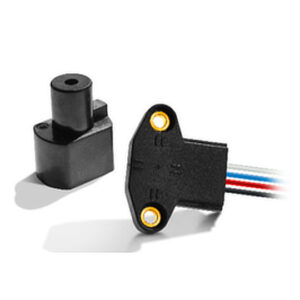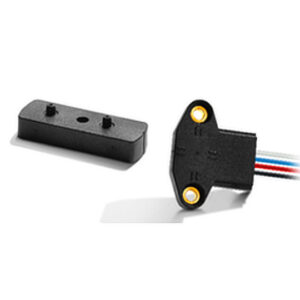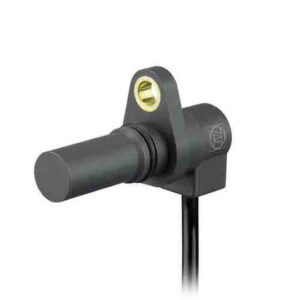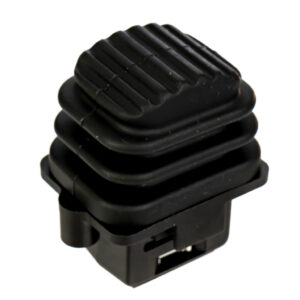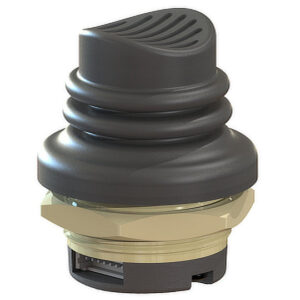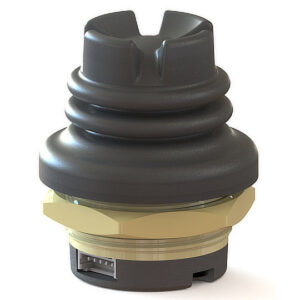Hall Effect Joysticks, Switches & Sensors
Live Electronics supply a range of Hall Effect Joystick, Rotary Switches and Sensors from companies such as Ruffy Controls, Elma and ZF.
Hall Effect joysticks allow for great variation from single axis paddles to miniature 4way finger-controlled joysticks that give repeatable accuracy, exceptional return to center voltages and the ability to have pre-programmed outputs in analog, CANbus, and USB or for custom outputs to be created. Elma’s X4 is a new style of rotary switch that can be used as an incremental encoder or an absolute coded switch, Live Electronics also carry a range of speed, direction and linear sensors from leading manufacturer ZF.
Hall Effect controls allow cycle lives between 1,000,000 and 15,000,000 cycles! All while giving the user greater feel and perception. The great variety of components that are now available in Hall Effect are allowing designers the freedom to create small, long lasting and above all reliable products that are perfect for Military, CCTV, Construction and Agricultural Vehicles, Conveyor systems, Robotics and ROV Control and Wheelchair Operation.
View Frequently Asked Questions about Hall EffectTS2 Series – Hall Effect Finger Joystick
The TS2 series of hall effect finger joysticks from Ruffy Controls are micro finger joysticks with a handle height of around 17.7mm (0.7”). Available in a 2-axis configuration with choice of 2 open or 2 gated limiters and designed to fit cut outs of 12.6mm (0.495”) diameter. The TS2 series has a choice of round convex, round concaved, castle or flat single axis (Y) style caps. Electrically rated for a...
View ProductHE2 Series – Hall Effect Joystick
The HE2 Series of hall effect joysticks from Ruffy Controls are available in 2 or 3-axis with options of 2 open or 3 gated limiters. Designed to fit cut outs of 1.63” or 1.75” diameter depending on mounting style the HE2 series also has a choice of 6 handle styles including options for 1 or 2 top buttons and standard or locked z-axis handles. Electrically rated for a supply voltage...
View ProductX4
The X4 series of Hall-Effect rotary switches from Elma are a new style of multi rotary switch which can be used as an incremental encoder or an absolute coded switch with outputs choices of Analog, PWM, Parallel and UART....
View ProductMSA Series – Micro Hall Effect Single Axis Joystick
The MSA series of micro hall effect single axis joysticks from Ruffy Controls are available in single or dual sensor configurations with a choice of convex knurled elastomer or convex plastic centre tabbed actuators that are around 0.6” high. Designed to fit cut outs of 0.89” by 0.41” the MSA series is electrically rated for a supply voltage of 5VDC with a mechanical life of 3 million actuations and sealed...
View ProductAN1/AN8/AN9/ANG Series
The AN1/AN8/AN9/ANG series of angle position sensors from ZF are non-contact position sensors utilizing hall effect technology....
View ProductLIN Series
The LIN series of linear position sensors from ZF are non-contact hall effect sensors offering linear voltage output and a long life. The actuator magnet included is specifically calibrated to the sensor for the most precise output and is custom programable on request for measuring range, slope and PWM output....
View ProductSD74/SD84/SDB4 Series
The SD74/SD84/SDB4 series of speed and direction sensor kits from ZF are designed with two internal hall effect cells, one that detects speed and, in combination with the second, detects the directions of movement....
View ProductSAT Series – Hall Effect Single Axis Joystick
The SAT series of hall effect single axis joysticks from Ruffy Controls are offered with a choice of low-profile ribbed wheel or 1.5” high paddle actuators. Designed to fit cut outs of 0.90” by 0.64” the SAT series is electrically rated for a supply voltage of 5VDC with a mechanical life of 2.5 million actuations in both directions and sealed to IP67....
View ProductSS1 Series – Hall Effect Miniature Finger Joystick
The SS1 series of hall effect miniature finger joysticks from Ruffy Controls are available in a 2-axis configuration with 4-way gated limiter. Designed to fit cut outs of 0.985” diameter the SS1 series has a choice of stepped, scooped, castle or pushbutton style caps. Electrically rated for a supply voltage of 1.5-3.6VDC with a mechanical life of 5 million actuations in all directions and sealed to IP67....
View ProductTS1 Series – Hall Effect Finger Joystick
The TS1 series of hall effect finger joysticks from Ruffy Controls are miniature joysticks with a handle height of around 25.4mm (1”). Available in a 2 axis configuration with choice of 2 open or 3 gated limiters and designed to fit cut outs of 24.6mm (0.97”) or 25mm (0.985”) diameter depending on mounting style. The TS1 series has a choice of stepped, scooped, castle or pushbutton style caps. Electrically rated...
View ProductFrequently Asked Questions about Hall Effect
The Hall Effect principle is that when a current is passed in one direction through a conductor and a magnetic force is introduced perpendicular to this, the magnetic field moves the electronics within the conductor creating a voltage change. You can then measure the change in voltage by taking a reading at right angles to the currents path, this measurable voltage is the Hall Effect.
Hall Effect is important within electromechanical devices as it allows for the accurate positioning or sensing of mechanical devices such as joysticks or gear tooth speed sensors. The main advantage of Hall Effect devices is that they are immune to dust, dirt and water and due to their frictionless operation they have extremely long electrical lives.
Hall Effect measure the change in voltage across a conductor where a current is been passed whilst a magnetic field is been introduced via magnets perpendicular to the conductor.
The Hall Coefficient is represented mathematically by RH and is 1/(qn) where q = charge and n = number of charge carriers per unit volume. The Hall Coefficient can be either positive or negative.
Hall Effect sensors are very reliable and robustly built however they can fail due to physical or electrical damage. Physical damage can usually be seen visually such as the casing being cracked or dented due to a heavy impact. Electrically the input voltage can be incorrect, or damage could have happened to the internal wiring due to being dropped etc. They can also malfunction if they are not set up within the device in an optimal way eg. too far away from the gear teeth in a gear tooth speed and directional sensor.

